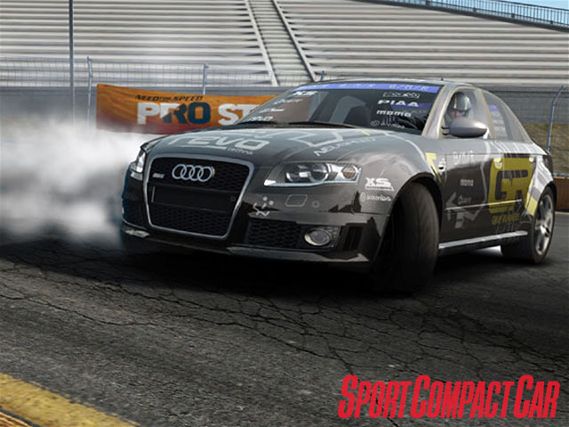 | Project Virtual Volkswagen GTI
| Project Virtual Volkswagen GTI
It's no secret Formula One drivers use them to get acquainted with unfamiliar circuits. Champ Car and NASCAR guys use them as well. In fact, in the current generation of amateur and professional drivers, you'd be hard pressed to find anyone who hasn't at least tried video games to gain an edge before a race or even a track day.
All the SCC staff do it too. Says editor Tate: "Before going to Laguna Seca for the first time, I had already been around the track thousands of times-on Gran Turismo 4. Playing the game gave me a mental map of which corners were coming next, and even helped provide a rough estimate of corner entrance speed. I was shocked by the accuracy after driving the actual track."
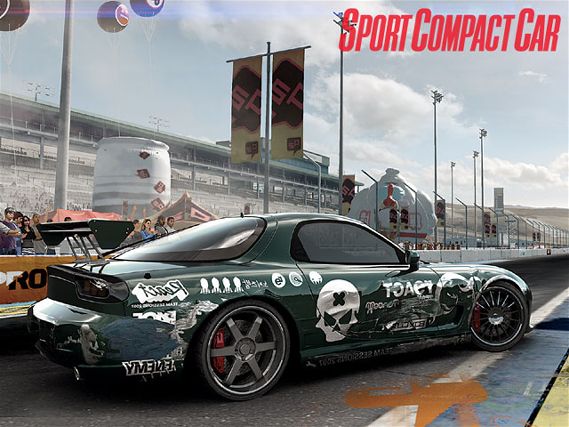 | Actual screen capture from EA's upcoming Need For Speed Pro Street video game.
| Actual screen capture from EA's upcoming Need For Speed Pro Street video game.
Clearly, video games like Polyphony's Gran Turismo, Microsoft's Forza franchise, and Electronic Arts' (EA) Need For Speed series offer benefits in the form of track practice and familiarization, but is there something more they can offer? Insight into real tuning, perhaps?
The logic is there. Video games, particularly those in the racing simulation category, stake their reputation on the authenticity of the circuits, conditions, vehicles and their performance. Companies spend thousands of dollars digitally recreating the finest details of race tracks around the world, including surface type, camber, elevation change, even the kinds of grass and gravel in the no-talent zone. They develop complex algorithms to simulate every possible condition on these tracks accurately, from obvious situations like rain and snow, to more subtle variables like the change in track temperature due to shadows and light.
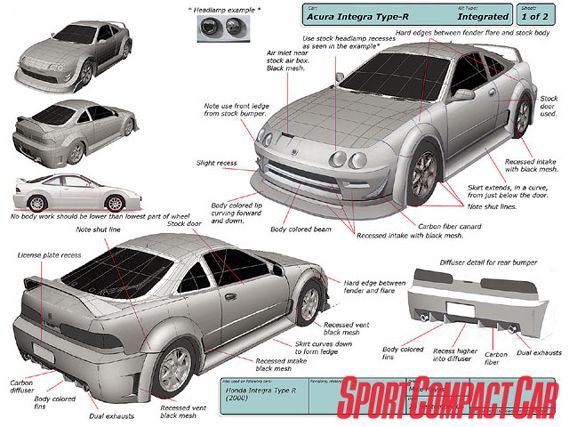 | Here's a look at just one of many design sheets generated by NFS PS game developers and designers. Yup, the ITR is in the game.
| Here's a look at just one of many design sheets generated by NFS PS game developers and designers. Yup, the ITR is in the game.
And then there are the cars. The attention to detail paid to selection and development of vehicles is even more highly touted than realism of the tracks and conditions. Given the effort game developers put into creating an accurate racing environment, it stands to reason that forming the stars of the games-the cars-would be even more demanding.
John Doyle, a game producer for EA, had this to say about the latest version of its popular Need For Speed series: "Our cars are amazingly accurate. Each is built from either real CAD data obtained from the manufacturers (accurate to the millimeter), or we laser-scan it ourselves. The latter entails putting masking tape over a real-life car and doing a 3D scan. It is the second most accurate way of obtaining the necessary vehicle information (with CAD data being the first). This high level of detail means we're now spending upwards of 95 days to build out each of our new cars."
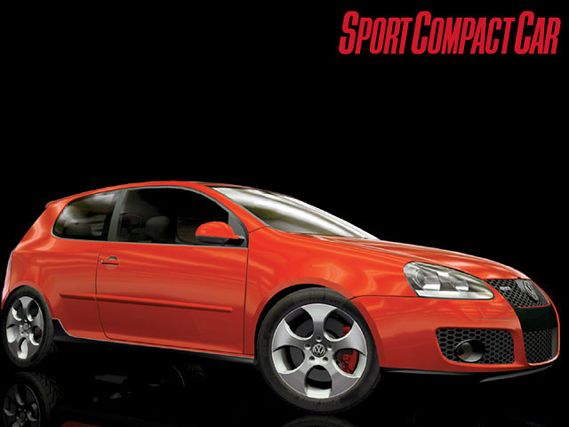 | Project Virtual GTI-stock, ready to rock.
| Project Virtual GTI-stock, ready to rock.
But at the end of the day (or in this case, day 95), how real is it? It may look real, but how much can you trust the performance of a virtual car on a virtual track, racing under virtual conditions? Can modifications made to cars in a virtual environment tell us anything about real-world tuning?
This is the subject of our next project car build-Project Virtual GTI.
The Concept
Evaluating the accuracy of racing games isn't particularly new. Many media outlets in both the gaming and auto industry have run gamers versus racers on the same tracks and in the same cars; edmunds.com and Popular Science magazine ran two notable tests recently.
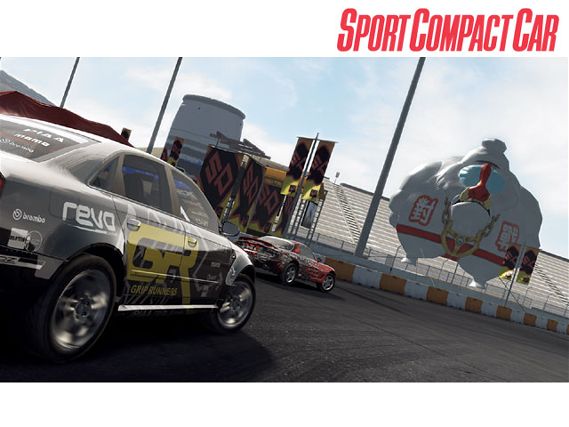 | Project Virtual Volkswagen GTI
| Project Virtual Volkswagen GTI
What we're doing is different: not simply comparing lap times on virtual and real race tracks, but comparing the performance of a virtual, video game car to one we build in the real world. The idea is to build two versions of our next project car: one in the real world, with real performance upgrades. Its virtual counterpart will be created within the confines of a video game, and will receive modifications and upgrades as close as can be configured to our real car.
Which Game?
When we talked to EA about its next-generation Need For Speed, we were, admittedly, a bit suspicious. The series is certainly impressive. It's the company's best-seller, and one of the best-selling video games of all time, with sales of over 75 million worldwide. That's a massive number, sure, but our staff was pretty evenly split over the sober tradition of Gran Turismo 4 and Forza's commitment to tuning.
Then we were invited north, to EA's Vancouver headquarters, to look at the upcoming Need For Speed Pro Street (NFS PS). Doyle claims it is a break from arcade-style driving games, and more accurately represents what really goes down on the streets and in the high-performance tuning culture.
"Need For Speed Pro Street is about competing at the highest level of street racing to separate the street kings from the trailer queens," Doyle continues. "This game is not about buying a stock car and driving it as such. It's about taking that car, making it yours, and having those mods pay off on the streets and tracks."
After meeting the development team and seeing the lengths to which they have gone to ensure an accurate and realistic racing experience, we were impressed. But what really sealed the deal were the two characteristics the GT and Forza franchises simply do not have: multi-platform support and local track modeling.
Multi-platform support: Gran Turismo is only for PlayStation aficionados, while Forza is only for Xboxers. Most of our friends only have one or the other, especially the new high-dollar sets. We needed a game that offers the ability to compare notes (talk trash) with everyone. NFS PS is such a game, playable on PlayStaion 2 and 3, Xbox 360, PC and Wii.
Local track modeling: We've been pushing this point for a long time now. While it is great to run world-famous tracks like Daytona and the Nrburgring's Nordschleife, the majority of amateur and armchair racers will only see track time on smaller, less exotic tracks.
We've never really understood why popular game developers haven't taken the time to recreate the popular racing tracks in our own backyard. Tracks like California Speedway, Willow Springs International Raceway and Buttonwillow Raceway are 'home tracks' for thousands of Southern California car nuts. Not only are there events going on every weekend for amateur and professional racers, but during the week many car and parts manufacturers use these tracks for research and development. Furthermore, we're only one of the many magazines that use these tracks for testing and evaluation.
Having one of these circuits in the game will allow us to compare real vehicle performance against virtual at every step of the way. The guys at EA assure us that NFS PS will have at least one local Southern California track we can test on.
Which Car?
With the game selection solved, the only matter now was what car to use. When completed, NFS PS should have a wide range of vehicles, representing the last 40 years of automotive performance, separated in categories ranging from hot rods to exotic supercars to tuned sport compacts. Says Doyle: "We wanted to make sure we offered cars for everyone, spanning the spectrum of domestics, exotics, imports, muscle, and anything else in between. There are also those iconic cars that, at the time, may have seemed like any other car, but now we look at those as a cut above the rest (e.g. AE86 Toyota Corolla)."
So why are we choosing a VW GTI?
A few reasons. As we've said in previous stories, the GTI is the right car for this market. It's fast, affordable, and a stellar drive around the track, though one that could use some serious aftermarket sharpening. It's also the first German car SCC has done in a long time.
Our other reasons are more practical. Though there is some overlap with the cars in the game and the ones in our fleet, trying to build a virtual car to match some of our longer-running projects just doesn't make sense-on many levels. For instance, despite EA's commitment to authenticity, we have serious doubts that NFS PS can adequately simulate a four-year-old supercharged 350Z, with 93,000 miles and really bad blow-by.
So there you have it. We're taking on another project car. Two, if you count the one we'll be building in the game. In upcoming issues, look out for Project Virtual GTI as we figure out exactly where the rubber meets the road when it comes to virtual versus street performance.
